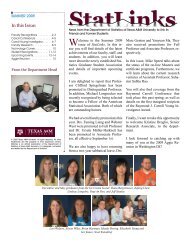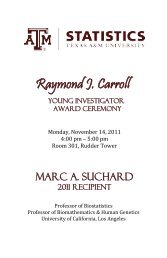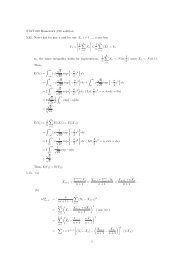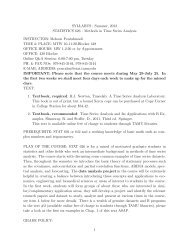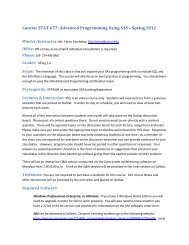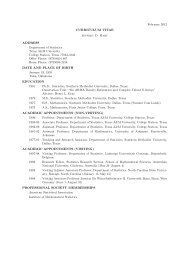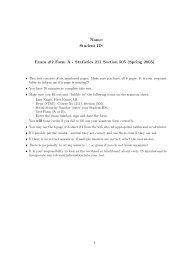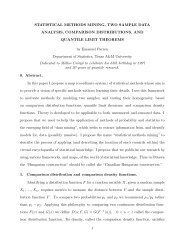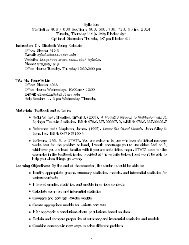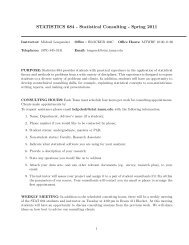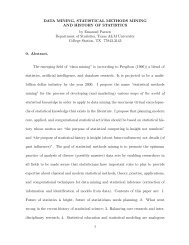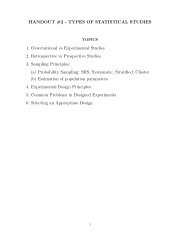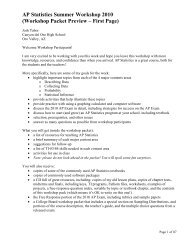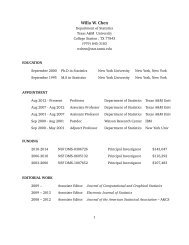STATISTICS 689 Introduction to Applied Bayesian Methods Fall ...
STATISTICS 689 Introduction to Applied Bayesian Methods Fall ...
STATISTICS 689 Introduction to Applied Bayesian Methods Fall ...
You also want an ePaper? Increase the reach of your titles
YUMPU automatically turns print PDFs into web optimized ePapers that Google loves.
<strong>STATISTICS</strong> <strong>689</strong><br />
<strong>Introduction</strong> <strong>to</strong> <strong>Applied</strong> <strong>Bayesian</strong> <strong>Methods</strong><br />
<strong>Fall</strong> Semester, 2012<br />
Instruc<strong>to</strong>r<br />
Office<br />
Jeff Hart<br />
459E Blocker Building<br />
Phone 979-845-1467<br />
Email<br />
Office hours<br />
Course website<br />
Prerequisites<br />
Text<br />
hart@stat.tamu.edu<br />
10:30-11:30 MW, 9:00-10:00 F, or by appointment<br />
We will use the DOSTAT course management system. I have<br />
sent you information on how <strong>to</strong> register for DOSTAT.<br />
STAT 604 – Statistical Computation<br />
STAT 608 – Regression<br />
STAT 630 – Overview of Mathematical Statistics<br />
Peter D. Hoff, A First Course in <strong>Bayesian</strong> Statistical <strong>Methods</strong><br />
Course Description<br />
This course is concerned with <strong>Bayesian</strong> statistics, which is a particular approach <strong>to</strong> statistical<br />
inference that differs philosophically and operationally from the classic frequentist approach. After<br />
defining <strong>Bayesian</strong> inference, its advantages will be discussed, and its application illustrated using<br />
some classical models, including binomial, Poisson and normal data, the multivariate normal model<br />
and linear regression. Hierarchical models are also defined and discussed. <strong>Bayesian</strong> inference is<br />
based on a so-called posterior distribution, which can only be computed exactly in relatively simple<br />
cases. Therefore, a modern method of approximating posteriors, known as Markov Chain Monte<br />
Marlo, is treated.<br />
Course Objectives<br />
The objective of this applied master’s level course is <strong>to</strong> introduce students <strong>to</strong> the <strong>Bayesian</strong> paradigm<br />
for data analysis. Students learn how uncertainty regarding parameters can be explicitly described<br />
as a posterior distribution that blends information from a sampling model and a prior distribution.<br />
Students are exposed <strong>to</strong> foundational principles, but the course emphasizes modeling and<br />
computations under the <strong>Bayesian</strong> paradigm.<br />
Course Outline<br />
The course will follow the textbook fairly closely, covering Chapters 1-11.
Homework<br />
About ten homework assignments will be made over the course of the semester. Distance students<br />
will submit their homework via WebAssign. Local students may either submit their homework in<br />
class or email it <strong>to</strong> me. I may not grade every homework problem, but feel free <strong>to</strong> discuss any of the<br />
problems with me. You may consult with other students about the homework, but always write<br />
up solutions by yourself. You should never just copy from another person or any other source.<br />
Exams<br />
You will have two midterm exams, which are tentatively scheduled for Wednesday, Oc<strong>to</strong>ber<br />
3 and Wednesday, November 14. Local students will take the exams during the usual class<br />
time, and distance students will take the exams via the proc<strong>to</strong>ring system used by all of the<br />
department’s distance courses. Effective <strong>Fall</strong> 2012, all students in Section 700 who are not<br />
receiving their complete degree in an online program (both STAT and non-STAT)<br />
must take the exam at the same date and time as the on campus students. Students<br />
must verify through an email <strong>to</strong> Penny Jackson that they are receiving their complete<br />
degree in an online program in order <strong>to</strong> take the exam outside the scheduled oncampus<br />
exam time. Please note the exam dates and times provided and make any<br />
special arrangements if necessary.<br />
Project<br />
Each student will choose a data set, which could come from his/her own research, or the internet.<br />
The student will develop a <strong>Bayesian</strong> model for the data, and carry out an analysis of it. Good<br />
projects will require significant effort throughout the semester and will result in a substantial<br />
written report. More details will be given subsequently.<br />
Grading Policy<br />
The weights given <strong>to</strong> the four parts of the course are as follows:<br />
25% – Homework<br />
25% – Midterm 1<br />
25% – Midterm 2<br />
25% – Project<br />
Grades will be assigned using the traditional scale:<br />
A – 90 ≤ average ≤ 100<br />
B – 80 ≤ average < 90<br />
C – 70 ≤ average < 80<br />
D – 60 ≤ average < 70<br />
F – 0 ≤ average < 60<br />
Please note, however, that I might lower the cu<strong>to</strong>ffs. This would be done <strong>to</strong> make the discrepancy<br />
between, for example, an A and a B as large as possible.
University Excused Absences<br />
Definition: Details of what constitutes a University Excused Absence are available in the<br />
Student Rules (http://student-rules.tamu.edu/).<br />
Homework: Late homework is only accepted in the case of a University Excused Absence.<br />
Exams: Quoting from the University Excused Absence (http://student-rules.tamu.edu/<br />
rule07) section of the Student Rules, “To be excused the student must notify his or her<br />
instruc<strong>to</strong>r in writing (acknowledged e-mail message is acceptable) prior <strong>to</strong> the date of absence<br />
if such notification is feasible. In cases where advance notification is not feasible (e.g. accident,<br />
or emergency) the student must provide notification by the end of the second working day<br />
after the absence. This notification should include an explanation of why notice could not<br />
be sent prior <strong>to</strong> the class. If needed, the student must provide additional documentation<br />
substantiating the reason for the absence, that is satisfac<strong>to</strong>ry <strong>to</strong> the instruc<strong>to</strong>r, within one<br />
week of the last date of the absence.” In short, if you are unable <strong>to</strong> take an exam at the<br />
scheduled time you must notify me (Dr. Hart) as soon as possible. Missed exams will be given<br />
zero points except for a University Excused Absence. In the latter case, I will administer a<br />
makeup exam.<br />
Incomplete Grade: An incomplete grade will be given only if a student, due <strong>to</strong> a University<br />
Excused Absence, is missing one component of the course grade.<br />
STATEMENT ON DISABILITIES<br />
The Americans with Disabilities Act (ADA) is a federal anti-discrimination statute that provides<br />
comprehensive civil rights protection for persons with disabilities. Among other things, this legislation<br />
requires that all students with disabilities be guaranteed a learning environment that provides<br />
for reasonable accommodation for their disabilities. If you believe you have a disability requiring<br />
an accommodation, please contact the Office of Disabilities Services in Room B118, Cain Hall.<br />
The phone number is 845-1637.<br />
STATEMENT ON PLAGIARISM<br />
The handouts used in this course are copyrighted. By ”handouts,” I mean all materials generated<br />
for this class, which include but are not limited <strong>to</strong> syllabi, quizzes, exams, lab problems, in-class<br />
materials, review sheets, and additional problem sets. Because these materials are copyrighted,<br />
you do not have the right <strong>to</strong> copy the handouts, unless I expressly grant permission. As commonly<br />
defined, plagiarism consists of passing off as one’s own ideas, words, writing, etc., which belong<br />
<strong>to</strong> another. In accordance with this definition, you are committing plagiarism if you copy the<br />
work of another person and turn it in as your own, even if you should have the permission of that<br />
person. Plagiarism is one of the worst academic sins, for the plagiarist destroys the trust among<br />
colleagues without which research cannot be safely communicated. If you have any questions<br />
regarding plagiarism, please consult the latest issue of the Texas A&M University Student Rules,<br />
under the section ”Scholastic Dishonesty.”<br />
ACADEMIC INTEGRITY STATEMENT<br />
“An Aggie does not lie, cheat, or steal or <strong>to</strong>lerate those who do.”<br />
Information about the Honor Council Rules and Procedures can be obtained at the web site:<br />
www.tamu.edu/aggiehonor. If an instruc<strong>to</strong>r encounters a student cheating or not abiding by<br />
university rules then it is manda<strong>to</strong>ry that the instruc<strong>to</strong>r report the student <strong>to</strong> the Aggie Honor<br />
System Office: complete information at http://www.tamu.edu/aggiehonor.



